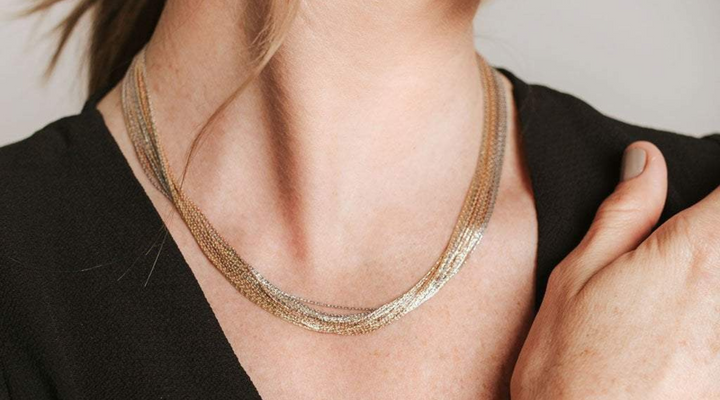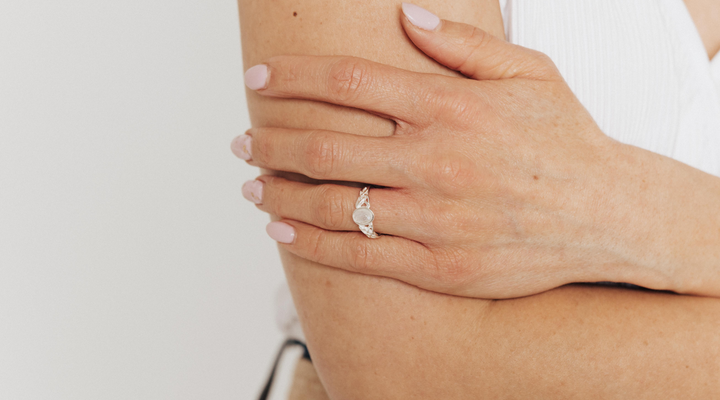Why Does Some Jewelry Stain Your Skin?
Posted by Deven Davis on

Why Does Wearing Some Jewelry Result In Stained Skin?
Have you ever taken off a ring or necklace only to reveal green or black stained skin underneath it? Click here to learn about when and why that happens.
Keyword(s): stained skin
Here's a misconception: only cheaply made jewelry can cause black or green stained skin. But the truth is, regardless of how high the quality of your jewelry is, you can still deal with sensitivities from it.
So, if it isn't the value of the metal, why does jewelry sometimes leave stains? You will find the answer to that question in this article along with ways to avoid stained skin in the future.
How Jewelry Causes Stained Skin
We've all had the experience where a piece of jewelry has caused our skin to turn green or black. While metal allergies and skin ailments are sometimes the reason for these unsightly marks, the majority of staining doesn't have anything to do with allergies.
Sometimes the products we use or the metals that are mixed in with the jewelry are the reason for stains. These are some metals that are commonly used in jewelry and how they can stain your skin when they tarnish:
Green Stains and Copper
We expose our skin to various elements and chemicals on a daily bases. This exposure comes from products like skin oils, perfumes, soaps, and lotions.
But if you like wearing copper jewelry, you may want to second guess actions like washing your hands while your rings are still on your fingers.
When copper is exposed to chemicals, it oxidizes and then turns greens. And of course, if you wear the jewelry for an extended amount of time, the tarnishing can transfer to your skin, leaving it green.
However, the full reaction can vary between people. It's your individual body chemistry that determines the impact of the tarnish.
Keep in mind that your jewelry doesn't have to be pure copper to cause a reaction.
Seeing Discoloration from Sterling Silver
Sterling silver is 92.5% pure silver. The remaining 7.5% is metal alloy like copper.
So, if you are experiencing some staining, it's possible that the copper is to blame.
On the other hand, when your sterling silver tarnishes, the result is usually black staining on the skin. The gasses in the air are what cause sterling silver to turn black.
Additionally, you will often find sterling silver that is coated with other metals because they help keep it from tarnishing. Rhodium, a member of the platinum metal family is commonly used in this way. It can also be the reason your sterling silver has a nice glossy finish.
Regarding care, you should store your sterling silver jewelry in its own compartment in our jewelry box. Or you can put it in a cloth pouch. Care for the jewelry this way helps prevent scratching, as silver is a very soft metal.
Reactions from Gold
It's very rare for gold to stain your skin on its own. However, it is often mixed with other metals and that's what causes problems.
Gold plated jewelry contains a thin outer layer of gold that can wear off with time. When it does, its less expensive base metal is exposed.
Metals like Nickel, silver, and copper get used with gold plated jewelry in order to make it affordable and durable. Those other metals are what cause skin discoloration and tarnishing.
When you purchase gold jewelry, you can determine how well it will hold up by understanding the number of karats a piece contains. The lower the number of karats, the less pure gold in the jewelry. For example, 10K gold jewelry contains less gold than 18K gold.
You should store and care for gold plated jewelry in the same ways you would sterling silver. Reduce its exposure to perfumes, lotions, and soaps. Then, store it in a cloth pouch to prevent the outer layer of gold from scratching off.
Nickel Allergies and Stained Skin
Just like other metals, nickel can stain your skin. But if your skin is sensitive or you have a nickel allergy, you can experience some other symptoms.
People with nickel allergies often experience itching and redness when the metal comes in contact with their bodies.
When purchasing jewelry, always ask the jewelry what types of alloy metals it is combined with. This way, you can avoid nickel and any reactions your allergy might cause.
Avoiding Staining All Together
The good thing is that your skin turning color from your jewelry isn't permanent or harmful. You can easily remove it by cleaning your skin with rubbing alcohol and then following up with soap and water.
But, if you could, wouldn't you avoid it all together?
Here's what to do:
Wear Other Metals
Certain metals are better for people with sensitive skin who are more likely to experience staining. The best metals to wear in this situation are rhodium, stainless steel, and platinum.
Remove Your Jewelry
The best way to protect your jewelry and your skin is to keep the jewelry safe during everyday activities. For example, if you are washing your hands, take your rings off. Or if you have are going swimming, especially in salt water, remove your jewelry.
Limiting exposure to chemicals will prolong the life of your jewelry and protect your skin.
Coat It
Since everyday chemicals, air, and water can scratch and tarnish your jewelry, you should coat it when it's brand new. Doing so will keep your jewelry in its best shape.
While some people use nail polish to provide a protective layer over their jewelry, the nail polish will eventually fade and need to be reapplied.
A polymer coating is much more durable and can do the trick. Additionally, you won't have to worry about finding a coating that will match the pieces you're trying to protect, as it is always clear in color.
Need More Jewelry Advice?
Nobody wants to lose their favorite pieces of jewelry to oxidation, stained skin, or tarnishing. Following the advice we provided in this guide will help you keep all of those things under control.
But that isn't where our jewelry advice ends. Follow our blog to learn interesting tips and even some history.
Like this blog post? Don't forget to pin it!






